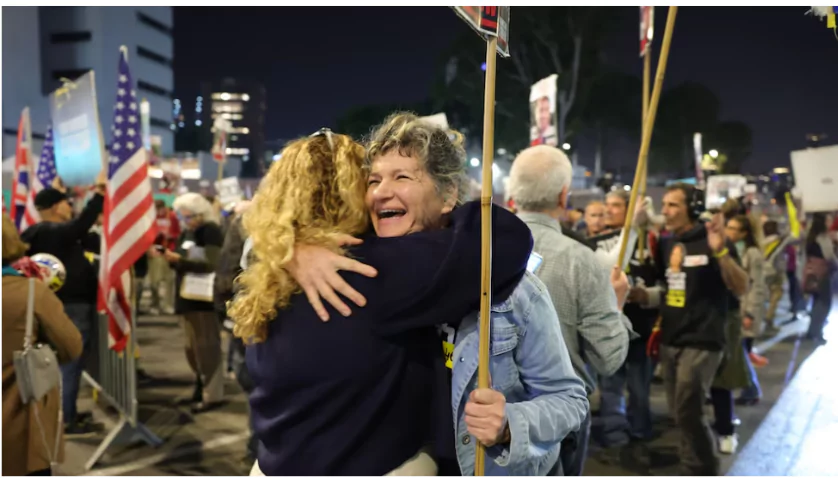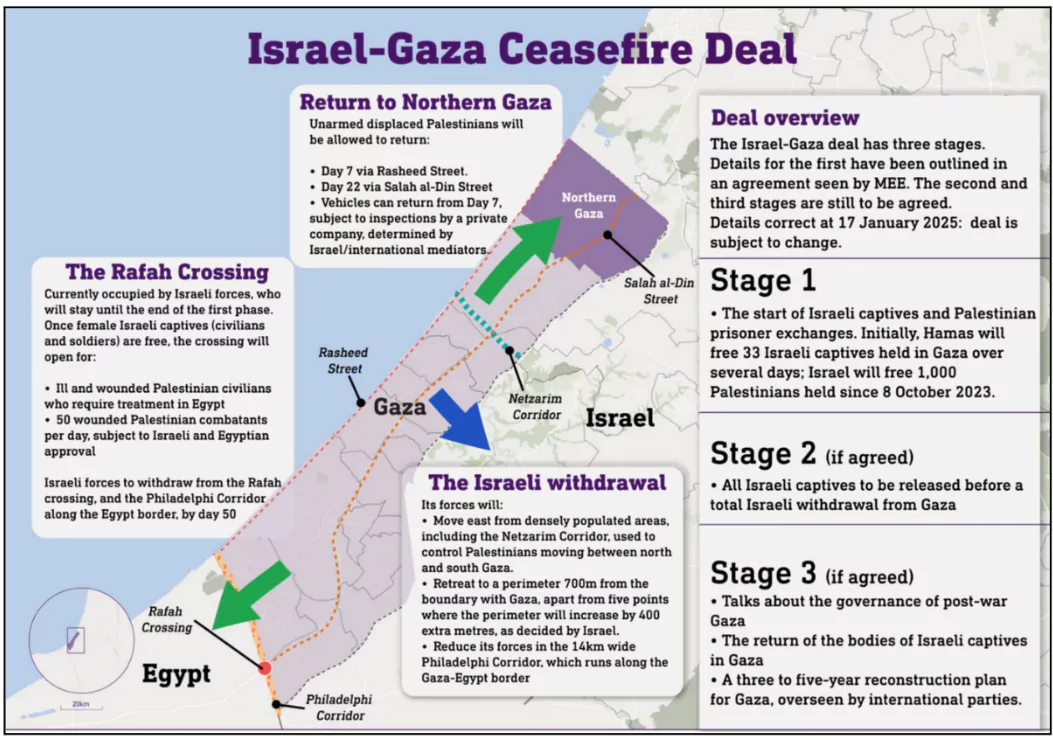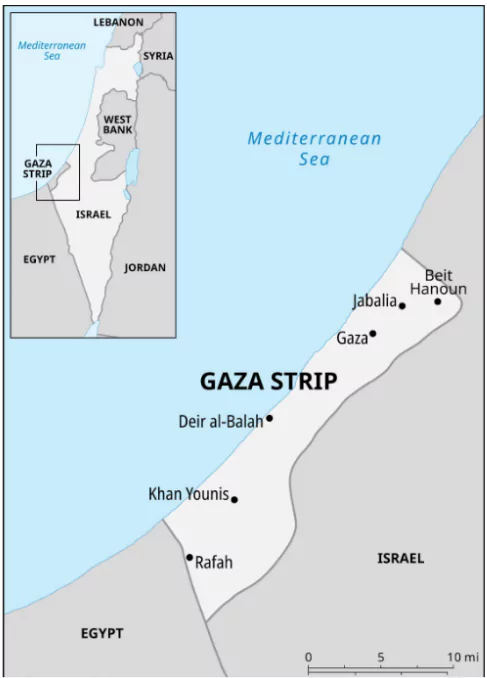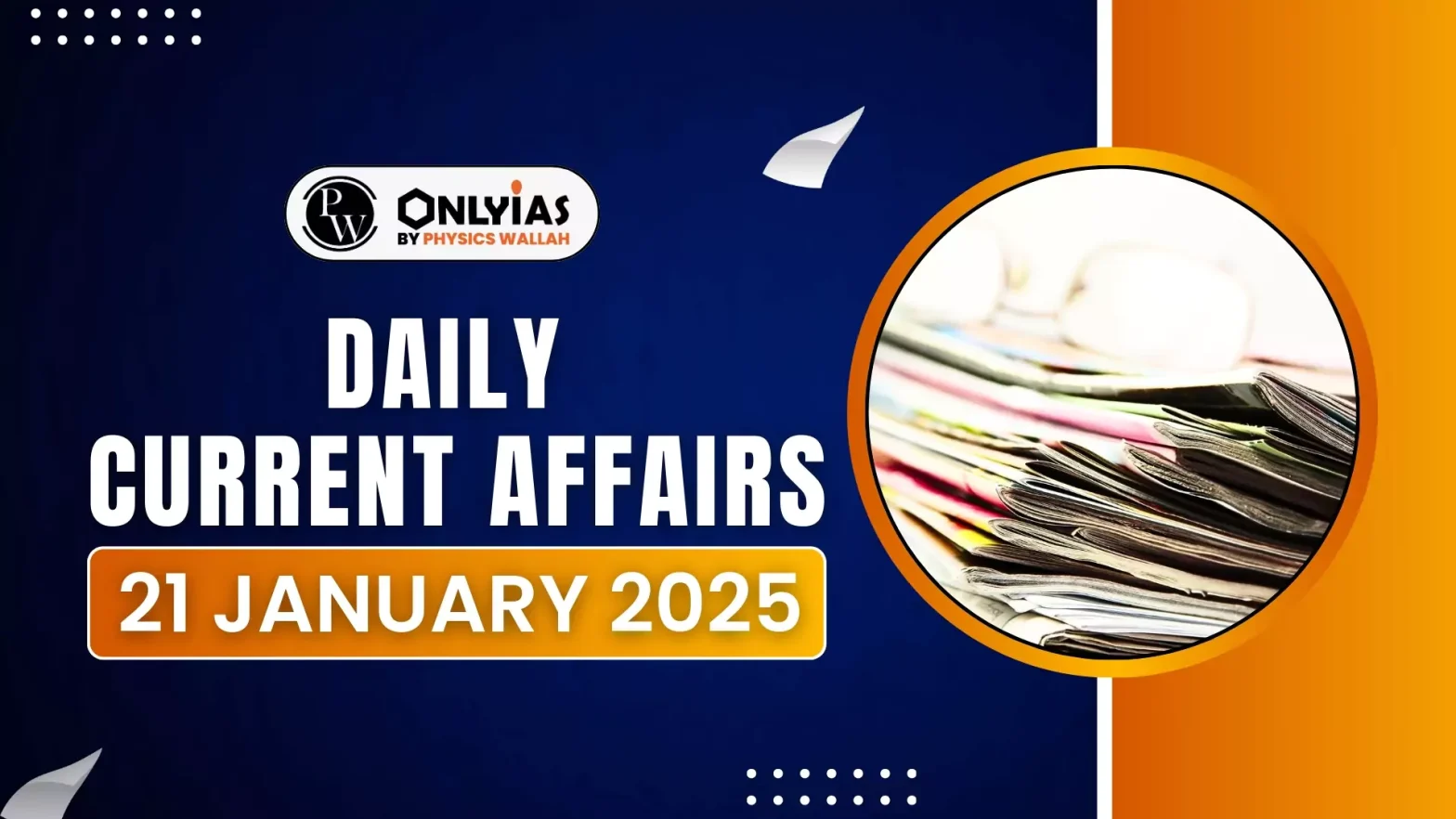After 15 months of war, which saw the deaths of tens of thousands of people, the destruction of much of Gaza and multiple rounds of painstaking negotiations, Hamas and Israel have agreed to a ceasefire.
Background of the Ceasefire

- The Israel-Hamas ceasefire was implemented after a 15-month-long war that began on October 7, 2023.
- The war caused severe casualties, with over 46,900 deaths in Gaza, the majority being civilians, and the displacement of nearly 2 million people in Gaza.
- In Israel, 1,200 people were killed, and 251 individuals were taken hostage by Hamas.
- The ceasefire agreement was brokered through the diplomatic efforts of Egypt, Qatar, and the United States, based on a framework proposed by U.S. President Joe Biden, endorsed by the UN Security Council in June 2024.
Enroll now for UPSC Online Course
Key Features of the Ceasefire (three-phase agreement)
- Phase 1:
- The ceasefire is expected to last for six weeks.
- Hamas is set to release 33 hostages, while Israel will release approximately 1,900 Palestinian prisoners.
- Israeli forces will withdraw from populated areas in Gaza.
- Humanitarian aid, including 600 daily trucks of supplies, will be allowed into Gaza.
- Phase 2:
- Hamas will release the remaining male hostages, and Israel will complete its withdrawal from Gaza.
- Both parties are expected to negotiate terms for a permanent end to hostilities.
- Phase 3:
- Reconstruction efforts for Gaza will begin.
- Discussions will focus on the governance of Gaza, with possibilities of integrating the Palestinian Authority.

About Balfour Declaration
- A letter written by Arthur James Balfour, then British Foreign Secretary, to Lionel Walter Rothschild, a prominent member of the Anglo-Jewish community, on November 2, 1917.
- The letter expressed British support for the establishment of a “national home for the Jewish people” in Palestine.
Why Was the Balfour Declaration Issued?
- Support for the Zionist Movement: Zionists, led by figures like Theodor Herzl, sought a homeland for Jews due to persecution in Europe.
- Prominent Zionists in Britain, such as Chaim Weizmann, advocated for British backing.
- World War I Context: Britain sought Jewish support in Russia and the U.S. to sustain Allied war efforts.
- Strategic Importance of Palestine: Control over Palestine would help Britain safeguard the Suez Canal and protect its colonial interests, particularly in India.
|
Reasons for the Israel-Palestine Conflict
- Historical Background and Territorial Disputes: The conflict is rooted in competing nationalist movements, with Jews seeking a homeland in Palestine (following the Balfour Declaration of 1917) and Palestinians seeing the same land as their own.
- After the establishment of Israel in 1948, Palestinian Arabs were displaced, leading to long-standing territorial disputes.
- The Creation of Israel (1948): The United Nations’ 1947 partition plan proposed dividing Palestine into separate Jewish and Arab states.
- The Arab states and Palestinian leaders rejected the plan, resulting in the 1948 Arab-Israeli War when Israel declared independence.
- Occupation of Territories: After the 1967 Six-Day War, Israel occupied the West Bank, Gaza Strip, and East Jerusalem, territories claimed by Palestinians.
- Despite various peace efforts, Israeli settlements in these territories and military control over them have intensified the conflict, with Palestinians seeking self-determination and an independent state.
- Religious Significance: Jerusalem holds deep religious significance for Jews, Christians, and Muslims.
- Control over holy sites, particularly the Al-Aqsa Mosque (for Muslims) and the Western Wall (for Jews), fuels religious tensions.
- Disputes over Jerusalem’s status remain one of the most contentious issues in peace negotiations.
- International Involvement and Peace Processes: Various international actors, including the United States, United Nations, and the European Union, have attempted to mediate the conflict, with efforts like the Oslo Accords (1993) and the Road Map for Peace (2003).
Check Out UPSC CSE Books From PW Store
Oslo Accords (1993)
- Declaration of Principles on Interim Self-Government Arrangements was signed between Israel and Palestine Liberation Organization (PLO)
- It was part of the Arab-Israeli peace process that saw Israel recognising the Palestine Liberation Organization (PLO) as a formal representative of the Palestinians.
- The PLO, in turn, renounced terror activities.
- However, peace negotiations fell through by the end of 2000.
Road Map for Peace (2003)
- The 2003 Roadmap to Peace was drafted by ‘the Quartet’ (the US, the UN, Russia and the EU).
- Purpose: To establish clearly-defined benchmarks and goals for progress in the Israeli-Palestinian peace process, with the aim of reaching a comprehensive settlement by 2005.
|
Key Events in the Israeli-Palestinian Conflict
- 1949: Israel signs truces with Arab countries, and the Gaza Strip was under Egypt’s control.
Key Places
- Al Aqsa Mosque: It is one of the holiest structures in the Islamic faith known by Muslims as Haram al-Sharif, or the Noble Sanctuary, and by Jews as the Temple Mount.
- West Bank: West Bank is a landlocked territory in West Asia. It also contains a significant section of the western Dead Sea.
- Gaza Strip: The Gaza Strip is located between Israel and Egypt. Israel occupied the strip after 1967.
- Golan Heights: The Golan Heights is a strategic plateau that Israel captured from Syria in the 1967 war.
|
- 1956: Israel invades the Sinai Peninsula and the Gaza Strip in response to Egypt’s nationalization of the Suez Canal.
- 1957: Israel withdrew from Egyptian land, except from the Gaza Strip and the area of the Gulf of Aqaba, arguing that the Gaza Strip never belonged to Egypt.
- 1967: During the Six-Day War, Israel gains control of the Gaza Strip and the Sinai Peninsula.
- 1987: Palestinians initiate the first intifada against Israel.
- 1993: Arafat signs the Oslo Accords with Israel, committing to negotiating a two-state solution; Hamas launches suicide bombings in Israel.
- 2021: Israeli police raid Al-Aqsa Mosque, leading to an 11-day war between Israel and Hamas; casualties on both sides.
- 2023: Recent attacks by Hamas on Israel
- Jan 2025: Hamas-Israel have agreed to a ceasefire.
Implications of the Israel-Hamas Ceasefire
- For Hamas: The ceasefire is a victory.
- With its traditional organisation and leadership in dire straits after the relentless and indiscriminate Israeli air and ground action, the group needs time and resources to recoup.
- Humanitarian Relief in Gaza: The ceasefire allows a pause in violence, providing much-needed humanitarian aid to the Gaza Strip, where 1.9 million people are displaced.
- Over 630 aid trucks, including food and medical supplies, have already entered Gaza, addressing immediate survival needs of a population facing famine and disease.
Check Out UPSC NCERT Textbooks From PW Store
Who is Hamas?
- It is the largest Palestinian militant Islamist group and a significant political party in the region.
- It currently governs over 2.3 million Palestinians in the Gaza Strip.
- However, it is designated as a terrorist group by Israel, the United States, the European Union, the United Kingdom, and other countries due to its armed activities.
- Formation: Founded in the late 1980s during the first Palestinian intifada (uprising) against Israeli occupation, Hamas emerged from the Palestinian Muslim Brotherhood.
Hezbollah:
- Hezbollah, whose name means ‘Party of God’, is a Shiite Islamic militant organization from Lebanon.
|
- Stability in the Middle East: The ceasefire reduces immediate hostilities between Israel and Hamas, potentially lowering tensions with regional players like Hezbollah and Iran.
- It provides an opportunity for diplomatic engagements that could prevent the conflict from escalating into a broader regional war.
- Diplomatic Success for Mediators: Countries like the United States, Qatar, and Egypt, which brokered the deal, strengthen their positions as key peace mediators in the Middle East.
- This success could encourage further involvement of international actors in stabilizing the region.
- Political Challenges in Israel: The ceasefire has created political tension within Israel, with Prime Minister Benjamin Netanyahu facing criticism from far-right coalition members for negotiating with Hamas.
- His objective of ejecting Hamas from Gaza through military force remains unfulfilled.
- Reconstruction and Governance of Gaza: The agreement opens the door for discussions on Gaza’s reconstruction, which will require billions in international aid.
- The United Nations Development Programme stated that the violence had caused Gaza’s development to lag by 69 years.
- Impact on Global Perception: The ceasefire highlights the humanitarian cost of the conflict, increasing international pressure on both sides to pursue a permanent resolution.
- Allegations of war crimes and civilian casualties have placed Israel under scrutiny, which could impact its global standing and relationships with allies.
Implications of Ceasefire on India

- Energy Security: India imports over 80% of its crude oil, much of it from the Middle East, including countries like Saudi Arabia and Iraq.
- The ceasefire reduces the risk of oil price volatility caused by disruptions in the region.
- Strategic Partnerships: India has a strong defense and technological partnership with Israel, with annual bilateral trade exceeding $10 billion in 2023.
- The ceasefire helps maintain stability, enabling uninterrupted collaboration in key areas like agriculture, cybersecurity, and defense technology.
- Two-State Advocacy: India has historically supported the two-state solution, advocating for peaceful coexistence between Israel and Palestine.
- The ceasefire provides India an opportunity to reinforce its diplomatic stance, balancing its ties with Israel and its traditional support for the Palestinian cause, reflected in its consistent voting patterns at the United Nations.
- Geopolitical Standing: India’s emphasis on dialogue and non-alignment resonates globally, offering a platform to mediate or contribute constructively to the resolution of such conflicts.
- Diaspora Concerns: The safety of the large Indian diaspora in the Middle East, which exceeds 9 million, is directly linked to regional stability.
- During the war, many Indian workers faced employment and security risks, especially in Israel and neighboring Gulf countries. The ceasefire alleviates immediate concerns for these workers.
- Trade and Investment Opportunities: The Middle East accounts for nearly 40% of India’s trade, including energy imports and exports of food, pharmaceuticals, and technology.
- A stable region opens avenues for enhanced economic engagement, particularly with countries like Israel, which has expressed interest in investing in India’s innovation and defense sectors.
- Public and Political Sentiment in India: The ceasefire resonates with India’s domestic audience, reflecting its ethos of peace and stability.
- Political statements during the conflict from the Indian government emphasized humanitarian concerns, maintaining diplomatic balance without alienating any side.
Check Out UPSC Modules From PW Store
Challenges to Ceasefire Implementation
- Lack of Trust Between Parties: There is deep-seated mistrust between Israel and Hamas due to decades of conflict.
- Hamas views Israel’s military withdrawal with skepticism, fearing re-escalation, while Israel doubts Hamas’s commitment to peace, given its history of rearming during truces.
- Absence of Binding Guarantees: The ceasefire lacks written assurances for phases beyond the initial truce.
- Disputes over prisoner exchanges or military withdrawals in later phases could lead to renewed violence.
- Internal Political Instability: Israeli Prime Minister Netanyahu faces pressure from far-right coalition members opposing concessions to Hamas.
- Hamas appears to be seeking a role in Gaza’s governance, akin to Hezbollah’s integration into Lebanon’s government post-Taif Agreement in 1989.
- Complexities of Governance in Gaza: Disagreements over who will govern Gaza post-ceasefire remain unresolved.
- Extensive destruction of infrastructure (over 60% damaged) complicates rebuilding efforts and risks exacerbating tensions.
- Reconstruction of Gaza: According to a UN damage assessment, it might take 21 years and cost up to $1.2 billion to remove the more than 50 million tonnes of rubble that remain after Israel’s assault.
- Risk of External Interference: Regional actors like Iran and Hezbollah could destabilize the ceasefire by supporting factions that oppose peace.
- Their involvement could lead to proxy conflicts within Gaza.
- Potential Escalation of Minor Incidents: Even small-scale skirmishes or violations, such as border clashes or isolated rocket attacks, could derail the fragile ceasefire.
- Similar breakdowns occurred in past truces due to unresolved disputes.
- Lack of International Oversight: The absence of a robust monitoring mechanism makes it difficult to enforce compliance by both parties.
- Without international observers or mediators on the ground, accountability for violations remains limited.
Way Forward for Ensuring the Success of the Ceasefire
- Establish a Monitoring Mechanism: Deploy international observers, facilitated by mediators like the U.S., Egypt, and Qatar, to monitor compliance and address violations.
- Regular reporting and accountability can help build trust between Israel and Hamas.
- Ensure proper adherence to UNSC resolution 2334: UNSC resolution 2334 concerns the Israeli settlements in Palestinian territories occupied since 1967, including East Jerusalem.
- Strengthen Humanitarian Aid Delivery: Ensure uninterrupted and large-scale humanitarian assistance to Gaza, focusing on food, medical aid, and shelter for displaced civilians.
- Engage international organizations like the UN and WHO for effective coordination and transparent aid distribution.
- Initiate Inclusive Governance Discussions: Promote dialogue for establishing a unified Palestinian administration under the Palestinian Authority to govern Gaza.
- Involve all relevant stakeholders to reduce internal Palestinian divisions and foster stability.
- Ensure Phased Implementation of Agreements: Clearly define timelines and mutual responsibilities for subsequent phases of the ceasefire, including hostage exchanges and troop withdrawals.
- Guarantee adherence to these commitments with the support of international mediators.
- Reconstruction of Gaza: Mobilize global financial and technical resources to rebuild Gaza’s infrastructure, including homes, schools, and hospitals.
- Commit to long-term development plans that address economic needs and create job opportunities for Gaza’s population.
- Promote Broader Regional Dialogue: Leverage the ceasefire to foster dialogue between Israel, Palestine, and other regional actors to address underlying causes of conflict.
- Work towards a two-state solution as a sustainable resolution, supported by international efforts and regional cooperation.
Enroll now for UPSC Online Classes
Conclusion
The Israel-Hamas ceasefire presents a critical opportunity for humanitarian relief and regional stability, but its success depends on overcoming deep mistrust, political challenges, and effective implementation of long-term solutions. Ongoing diplomatic efforts, coupled with robust monitoring and reconstruction, are essential for achieving lasting peace in Gaza and the broader region.
![]() 21 Jan 2025
21 Jan 2025




